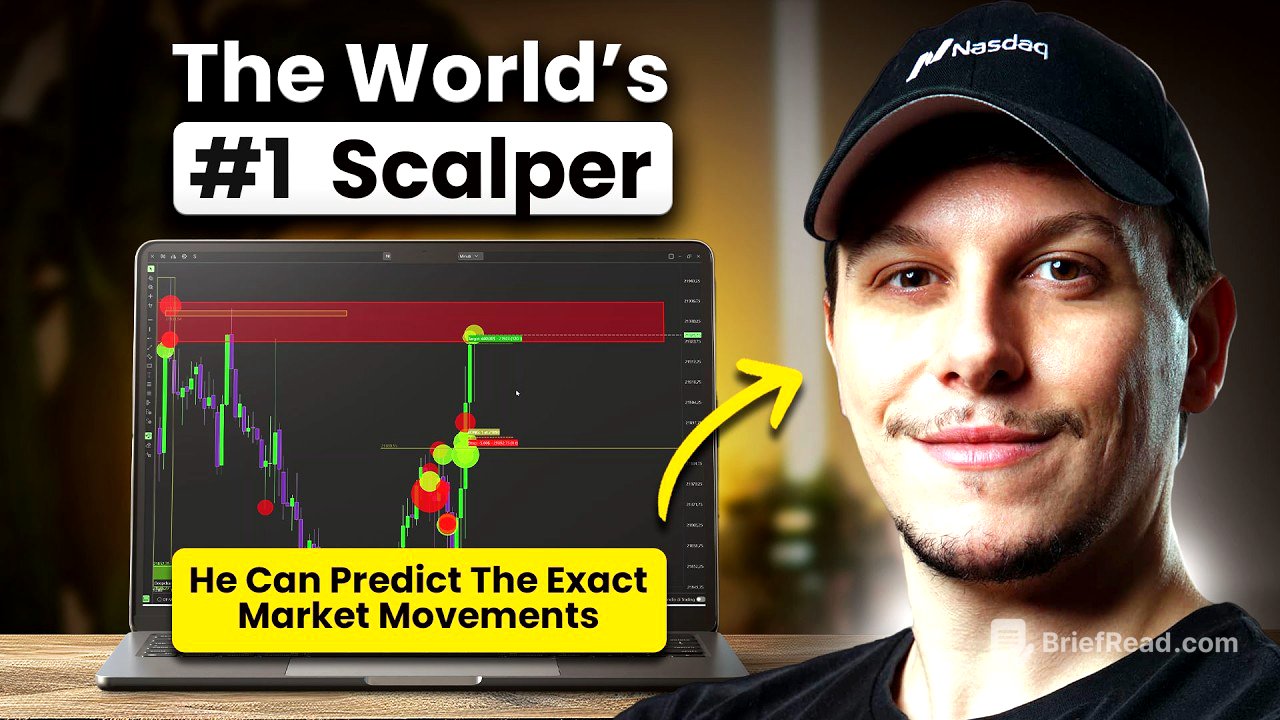TLDR;
This video features a detailed breakdown of a scalping strategy used by world-class trader Fabio Valentino, focusing on market structure, order flow, and risk management. He shares two primary models: a trend-following model for New York session and a mean-reverting model for London session, both leveraging volume profile and order flow analysis. The video emphasizes understanding market context over prediction, adapting to changing conditions, and the importance of precise execution.
- Focus on market context and order flow
- Two models: trend-following (New York) and mean-reverting (London)
- Importance of risk management and adapting to market conditions
Introduction to Scalping Strategy [0:00]
The video introduces Fabio Valentino, a world-class scalper who achieved over 500% return in a 12-month period in the futures division of the Robins Club. Valentino will share his strategy, emphasizing the importance of understanding market structure and dispelling common misconceptions about it. The discussion aims to provide insights into why most traders lose money and how to frame market analysis correctly.
Understanding Market Structure Misconceptions [2:18]
Valentino explains that 90% of traders lose money because they rely on trend-following strategies based on market structure shifts or breakouts without considering the broader market context. He argues that these patterns often fail because they don't account for the distribution of volume and the auction market theory (AMT). AMT views the market as an auction moving between balanced and imbalanced states, with traders frequently getting stopped out when trying to trade against the dominant volume distribution.
Auction Market Theory (AMT) and Model Building [5:14]
Valentino introduces AMT, explaining that markets oscillate between balance and imbalance. He emphasizes that traders often face stop-loss streaks because they attempt to anticipate market movements in balanced conditions. He advocates waiting for the market to enter an out-of-balance state to improve win rates. Valentino distinguishes his approach as a "model" rather than a "strategy," highlighting the need to understand the market's narrative and adapt to its dynamic nature, using the profile to time entries and identify key areas.
Three Steps of the Trading Model: Location, Validation, and Execution [7:19]
The first step involves understanding the location or market condition, focusing on trading efficiently when the market is out of balance. The second step is validating the level using order flow to read the market, identifying low volume nodes within breakout areas using volume profiles. The third step involves analyzing big orders and aggression to time entries, using order flow platforms to identify significant buy or sell orders, which helps in tuning into the market at the right moment and avoiding large stop losses.
Optimizing the Model: Session Timing and Mean Reversion [15:54]
The model works best during the New York session, specifically for equities like NASDAQ and ES, but is less effective during the first hour of the London session due to frequent fake outs. To counter this, Valentino uses a mean-reverting model during the London session, capitalizing on deep discounts based on volume distribution and waiting for breakouts before entering trades. This involves identifying areas where maximum volume has been transacted and waiting for big trades to confirm the move.
Order Flow and Risk Management [20:18]
Order flow enhances confirmation and alignment with larger orders, improving price action trading. Valentino emphasizes being wrong immediately and aggressively managing risk by setting stop-loss orders to break even after small movements. He highlights that order flow provides an edge by offering additional information, which is crucial for traders seeking to maximize profits. He also notes that institutional traders use order flow for alternative markets and short-term trading due to its effectiveness.
Edge Decay and Model Improvement [35:44]
Edge decay occurs when a trading model loses its effectiveness due to changing market conditions, often seen in price action strategies. Order flow helps mitigate edge decay by focusing on the true nature of the market, allowing traders to adapt and improve their models. Valentino shares an example of improving his model by using order flow to analyze breakouts, watching cumulative volume delta and order aggression to avoid false breakouts and increase win rates.
Model Summaries: Trend Following and Mean Reverting [38:57]
The trend-following model is best implemented during the New York session, focusing on imbalanced market conditions and avoiding balanced markets. The steps include understanding the market state, identifying swing points using volume profiles and low volume nodes, and executing trades based on aggression, with targets set at previous balance areas. The mean-reverting model, used during consolidation, aims to capitalize on out-of-balance conditions returning to balance, waiting for breakouts and retracements, and using low volume nodes and aggression to identify entry points.
Pros and Cons of the Models [50:09]
The mean-reverting model suffers from reduced win rates during compression days, leading to multiple small stop-losses. Both models can be stressful due to the high stakes and time commitment required. However, the high number of trades allows for quick recovery from drawdowns and provides valuable data for analysis. The models eliminate the need for prediction, reducing decision-making stress and preventing revenge trading. They also offer high-risk-to-reward ratios, especially in trending markets.
Chart Examples: Consolidation and Delta Analysis [58:57]
The video transitions to chart examples using an order flow platform, Deep Chart, to illustrate the models. It shows volume profiles of consolidation areas, highlighting how the market reverts to balance. Delta analysis is used to measure volume aggression at specific price levels, identifying areas of accumulation and distribution. The examples cover both reversion and trend-following models, demonstrating how to apply them in different market conditions.
Live Trading: London and New York Sessions [1:03:14]
The live trading segment begins with an analysis of the London session, noting the impact of geopolitical events on market volatility. The model identifies areas of buyer aggression and potential entry points. The analysis shifts to the New York session, emphasizing the importance of waiting for the market to establish direction before engaging. The session involves monitoring big trades, identifying key levels, and preparing for potential breakouts or rejections.
Pre-Market Analysis and Scenario Planning [1:22:11]
Before the New York session opens, Valentino analyzes the pre-market conditions, noting the battle between buyers and sellers. He creates rule-based scenarios, anticipating potential breakouts or liquidations based on market behavior. He emphasizes the importance of waiting for clear signals and avoiding trading during the volatile pre-market period.
Live Trading: Initial Market Open and Level Identification [1:25:55]
As the New York session opens, Valentino observes the market's initial movements, noting aggressive sellers and the importance of key levels. He emphasizes the need to wait for confirmation and avoid impulsive trades. He identifies potential long positions based on buyer aggression and the protection of key levels, while also remaining open to a short narrative if market conditions shift.
Order Flow Dynamics and Trade Execution [1:30:43]
Valentino discusses the parameters for identifying large orders, using 30 contracts as a filter for New York session and 20 for London session. He highlights the importance of seeing aggressive buyers to confirm a long position and notes that the market is still compressing. He emphasizes the need to wait for the right conditions and avoid forcing trades.
Waiting for Confirmation and Managing Risk [1:36:11]
Valentino stresses the importance of waiting for confirmation and avoiding trades within the noise. He discusses the potential for a squeeze if certain levels are broken and highlights the need to protect capital. He emphasizes that his primary focus is on risk management, which ultimately increases profitability.
Trade Management and Adapting to Market Conditions [1:40:24]
Valentino discusses the importance of adapting to market conditions and avoiding rigid biases. He emphasizes the need to be flexible and adjust the trading plan based on new information. He also highlights the importance of setting specific levels that invalidate the initial bias and being prepared to switch narratives if necessary.
Live Trade Execution and Analysis [1:42:38]
Valentino executes a long trade, emphasizing the importance of a full candle close above a key level. He discusses the risk-to-reward ratio and the need to protect the position. He also highlights the importance of understanding market participants and their potential actions.
Trade Progression and Risk Management Adjustments [1:45:48]
Valentino adjusts his stop loss to protect profits, emphasizing the importance of adapting to market behavior. He discusses the potential for a whipsaw and the need to be prepared for different scenarios. He also highlights the importance of having a clear plan and avoiding impulsive decisions.
Trade Outcome and Market Analysis [1:50:52]
Valentino's trade is stopped out, resulting in a small loss. He analyzes the market's behavior, noting the lack of follow-through from buyers and the potential for a reversal. He emphasizes the importance of adapting to changing market conditions and avoiding over-attachment to a particular bias.
Adapting the Strategy and Recognizing Market Compression [1:54:39]
Valentino discusses the importance of recognizing when the model is not working properly, such as during compression phases. He emphasizes the need to protect profits and avoid taking unnecessary risks. He also highlights the importance of having a clear plan and avoiding impulsive decisions.
The Importance of Market Knowledge and Experience [1:58:38]
Valentino emphasizes the importance of market knowledge and experience in making informed trading decisions. He discusses the need to understand the nuances of different assets and adapt to their specific behaviors. He also highlights the importance of having a clear understanding of risk management and avoiding over-leveraging.
The Value of Live Analysis and Verification [2:03:03]
Valentino stresses the importance of trusting only those who provide verification or live analysis. He highlights the difference between those who make money trading and those who make money pretending to trade. He also emphasizes the importance of having a clear understanding of risk management and avoiding over-leveraging.
Final Trade and Session Summary [2:05:58]
Valentino executes a final trade, emphasizing the importance of a full candle close above a key level. He discusses the risk-to-reward ratio and the need to protect the position. He also highlights the importance of understanding market participants and their potential actions.
The Importance of Protection of Capital and Risk Management [2:10:11]
Valentino emphasizes that when your primary focus gets to protection of capital and risk management, you increase the profit. He also highlights the importance of having a clear understanding of risk management and avoiding over-leveraging.
The Importance of a Clear Strategy and Playbook [2:13:25]
Valentino emphasizes the importance of having a clear strategy and playbook and sticking to it. He discusses the need to avoid impulsive decisions and to be patient in waiting for the right opportunities. He also highlights the importance of having a clear understanding of risk management and avoiding over-leveraging.
The Importance of a Long-Term Perspective and Avoiding Fairy Tales [2:26:19]
Valentino emphasizes the importance of having a long-term perspective and avoiding the temptation of quick riches. He discusses the need to be patient and to focus on building a sustainable trading strategy. He also highlights the importance of having a clear understanding of risk management and avoiding over-leveraging.
Final Thoughts and Session Conclusion [2:30:31]
Valentino concludes the session, emphasizing the importance of continuous learning and adaptation. He encourages viewers to focus on building a solid foundation and to avoid the temptation of get-rich-quick schemes. He also highlights the importance of having a clear understanding of risk management and avoiding over-leveraging.
Analyzing Market Reversals and Volume Dynamics [2:33:47]
Valentino analyzes potential market reversal points, emphasizing the importance of volume and order flow in identifying these areas. He discusses the need to avoid counter-trend trades and to focus on high-probability setups. He also highlights the importance of having a clear understanding of risk management and avoiding over-leveraging.
The Importance of a Clear Trading Plan and Avoiding Impulsive Decisions [2:40:34]
Valentino emphasizes the importance of having a clear trading plan and avoiding impulsive decisions. He discusses the need to be patient and to wait for the right opportunities. He also highlights the importance of having a clear understanding of risk management and avoiding over-leveraging.
The Role of Artificial Intelligence in Trading [2:43:35]
Valentino discusses the potential role of artificial intelligence in trading, particularly in risk management and position management. He highlights the importance of using AI to remove noise and improve decision-making. He also emphasizes the need to combine AI with human judgment and experience.
The Three Pillars of Successful Trading [2:45:02]
Valentino identifies the three pillars of successful trading: strategy, mindset, and risk management. He emphasizes that all three are equally important and that neglecting any one can lead to failure. He also highlights the importance of continuous learning and adaptation.
The Importance of Tuning into One Asset [2:39:27]
Valentino emphasizes the importance of tuning into one asset, such as NQ, to deeply understand its behavior and nuances. This focused approach allows traders to develop a strong intuition and make more informed decisions. He also highlights the importance of having a clear understanding of risk management and avoiding over-leveraging.
Final Trade and Session Conclusion [3:33:10]
Valentino concludes the session, emphasizing the importance of continuous learning and adaptation. He encourages viewers to focus on building a solid foundation and to avoid the temptation of get-rich-quick schemes. He also highlights the importance of having a clear understanding of risk management and avoiding over-leveraging.









